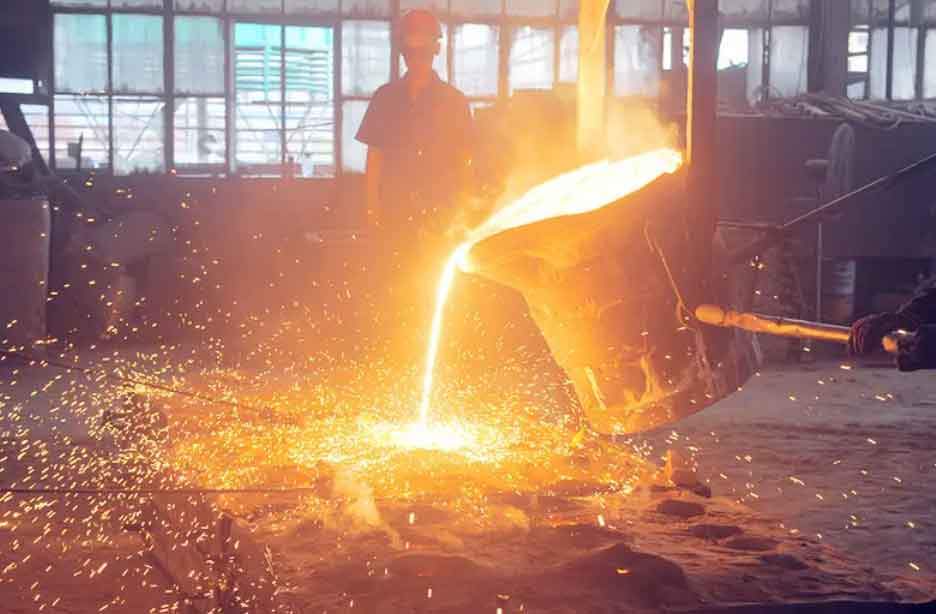Due to the differences in product structure, weight, process equipment of production enterprises, production conditions and process technology level, there are also some differences in the sand casting process scheme design of motor shell at home and abroad, but there are mainly the following schemes:
Scheme 1: horizontal molding and horizontal pouring, i.e. symmetrical parting along the axis of the motor shell. The inner sprue is set at the parting surface. The horizontal molding method is adopted and placed horizontally during pouring. The design and operation of this process scheme are relatively simple, but the feeding of sand castings is relatively difficult, especially in the convex part of the upper inner cavity with complex structure, there are basically no measures to solve the feeding problem; Sundries in the mold cavity, such as sand, slag and non-metallic inclusions, are not easy to float into the riser, and sand castings are easy to produce shrinkage, porosity, sand inclusion, inclusions and other defects. In order to solve these defects, technicians usually take measures to improve the strength of molding sand, increase the thickness of coating layer, increase subsidies and risers on the arc surface from the perspective of technology, but the effect is not ideal. Improving the strength of molding sand can reduce the defects of sand washing and sand inclusion, but it will bring a new problem – crack; Adding risers and subsidies on the circular arc can reduce shrinkage and porosity to a certain extent, but it has a great impact on the shape of sand castings. It is difficult to repair the sand castings by hand, and at the same time, it also increases the labor cost.
Scheme 2: horizontal molding and vertical pouring, that is, the mold is divided symmetrically along the axis of the motor shell. The horizontal molding method is adopted, and the sand mold is placed vertically during pouring. The advantage of this scheme is that the riser can be set at the upper end of the sand casting, which is convenient for feeding and has good compactness of the sand casting; Floating sand, inclusions and gas are easy to float up, and there are few sand inclusion and pore defects. This scheme is suitable for the production of small motor shell. It is not suitable for high and large products, and the sand casting is easy to deform.
Scheme 3: vertical molding and vertical pouring (top injection) scheme, that is, parting along the vertical direction of the axis of sand castings. Most of the sand castings are in the lower box, and the upper box has only riser (or a small amount of sand castings) and gating system. Molten steel is injected into the mold cavity from the parting surface in the form of top injection.
The advantages of this process scheme are:
① The setting of draft angle slows down the difference between the upper and lower wall thickness of sand castings to a certain extent;
② Top injection is beneficial to the formation of bottom-up sequential solidification and feeding of sand castings;
③ The riser is easy to set and the feeding effect is good.
The disadvantages of this process scheme are also obvious:
① It is not conducive to the stable filling of molten steel;
② The scouring force of molten steel is large and it is easy to wash sand;
③ It is not conducive to the floating sand and sundries in the mold cavity, and the molten steel in the mold cavity is easy to oxidize.
The typical problem of using this process scheme to produce motor shell is that there are many sand and slag inclusions in the inner cylinder. In order to solve the problem of sand inclusion caused by this process scheme, sand casting technicians have adopted many methods: setting a filter screen on the sprue, making the sprue with special sand, improving the strength of molding sand at the first scouring part of molten steel, etc., but the effect of sand inclusion is not satisfactory and can not meet the requirements of customer standards.
Scheme 4: vertical molding and vertical pouring (bottom pouring) scheme, that is, parting along the vertical direction of the axis of the sand casting. Most of the sand casting is in the lower box, and the upper box has only riser (or a small amount of sand casting). The inner sprue is set at the bottom of the sand casting, and the molten steel is injected into the mold cavity from the parting surface in the form of bottom pouring.
The advantages of this process scheme are:
① Molten steel filling is stable and not easy to sand;
② The floating sand and sundries in the mold cavity are easy to float up into the riser, and the sand inclusion of sand mold castings is less;
③ It is not easy to crack.
The first disadvantage is that there are many sprue cores and it is difficult to make and lower the core; Second, the feeding effect is not as good as the top injection type.
At present, this process scheme is mainly used in iron parts, and its application in steel casting motor shell is in the preliminary stage. However, many casting process designers believe that if this scheme is properly designed, coupled with local auxiliary measures, it is more suitable for some motor shells with high quality requirements.
The above four process schemes all adopt box machine modeling. During the actual implementation, they are equipped with some auxiliary measures, such as cold iron, special sand core, heating riser, coating, etc. The specific design and application position are closely related to the product structure and molding sand process.

